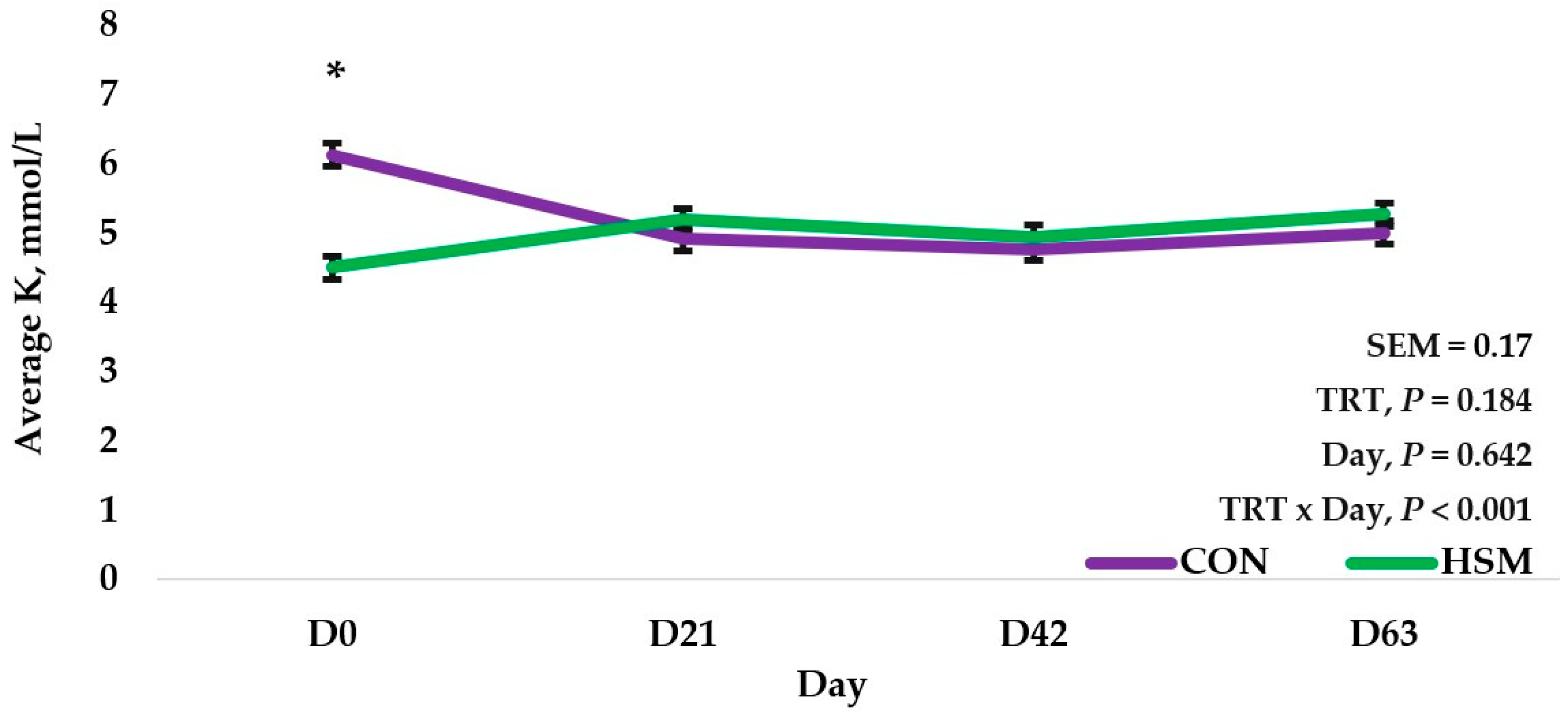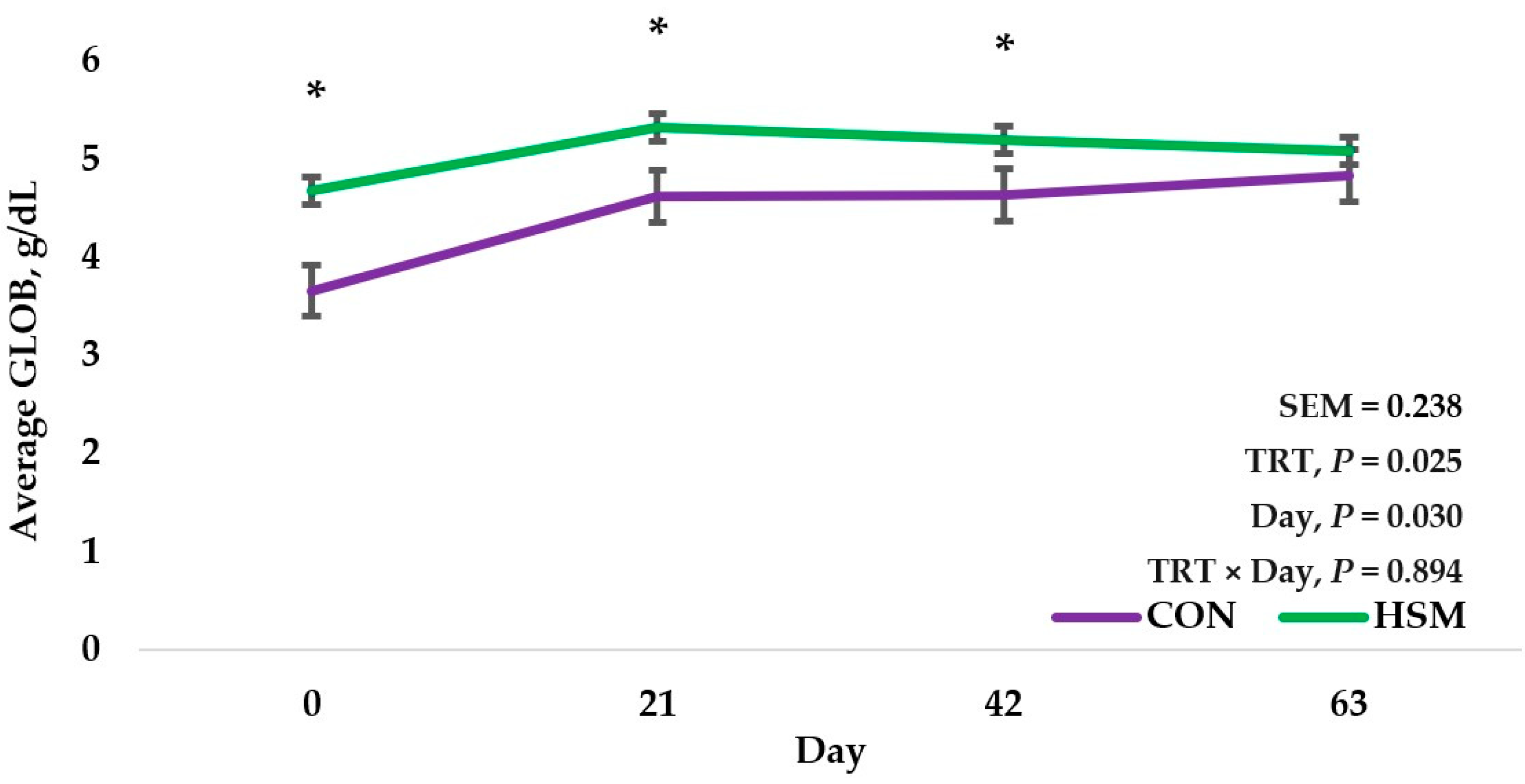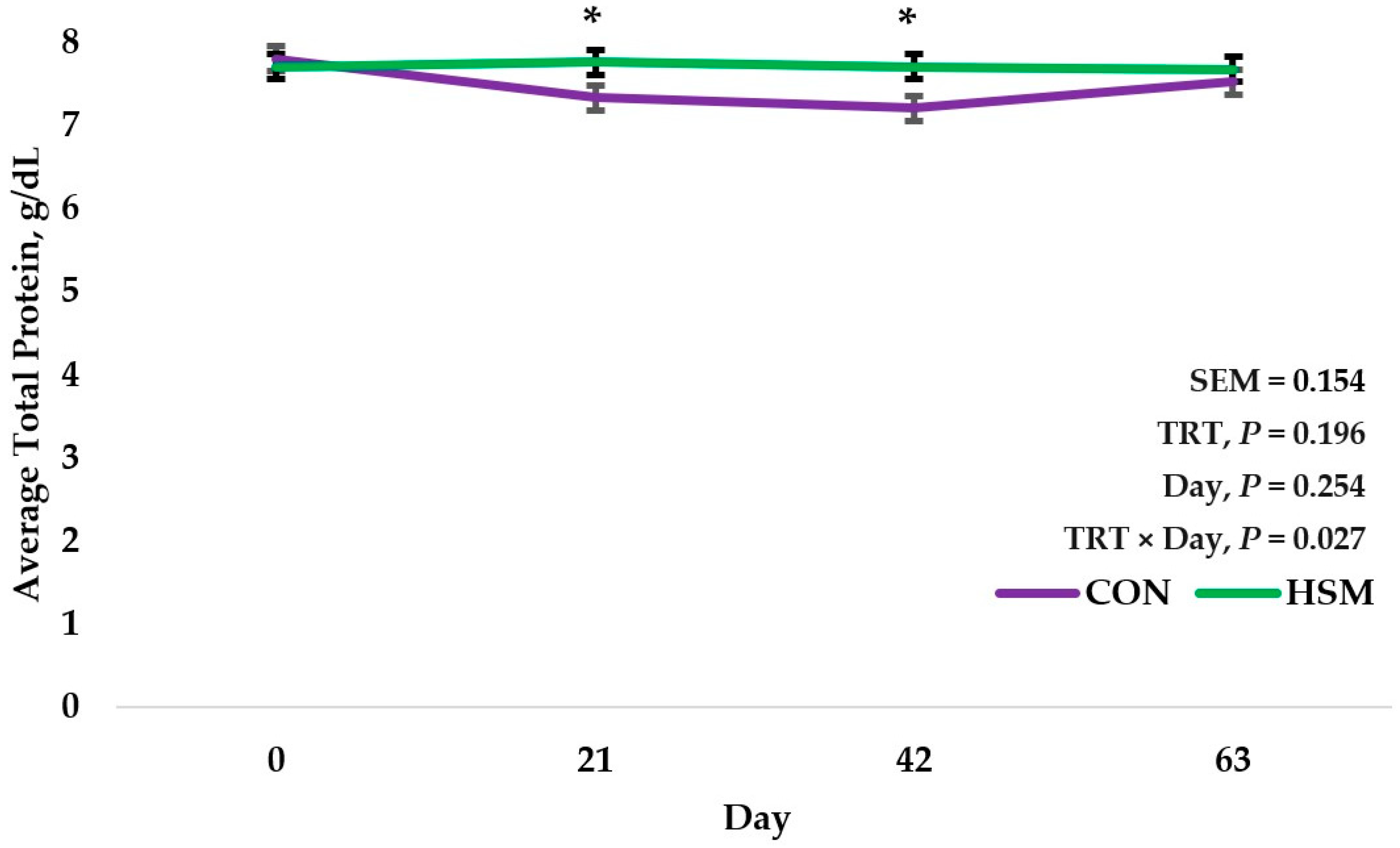Effect of Dietary Hempseed Meal on Growth Performance, Feed Efficiency and Blood Parameters in Yearling Rough Stock Bulls
Abstract
Simple Summary
Abstract
1. Introduction
2. Materials and Methods
2.1. Animal Care and Use
2.2. Experimental Design and Treatments
2.3. Sample Collection
2.4. Laboratory Analysis
2.5. Statistical Analysis
3. Results
3.1. Growth Performance and Feed Efficiency
3.2. Plasma Urea Nitrogen
3.3. Other Blood Parameters
4. Discussion
5. Conclusions
Author Contributions
Funding
Institutional Review Board Statement
Informed Consent Statement
Data Availability Statement
Acknowledgments
Conflicts of Interest
References
- Hemp in US Animal Feed Is One Step Closer to Fruition. Available online: https://hempindustrydaily.com/hemp-in-animal-feed-is-closer-to-becoming-reality/ (accessed on 28 March 2024).
- House, J.D.; Neufeld, J.; Leson, G. Evaluating the quality of protein from hemp seed (Cannabis sativa L.) products through the use of the protein digestibility-corrected amino acid score method. J. Agric. Food Chem. 2010, 58, 11801–11807. [Google Scholar] [CrossRef] [PubMed]
- Hessle, A.; Eriksson, M.; Nadeau, E.; Turner, T.; Johansson, B. Cold-pressed hempseed cake as a protein feed for growing cattle. Acta Agric. Scand. Sect. A Anim. Sci. 2008, 58, 136–145. [Google Scholar] [CrossRef]
- Dhondt, F.; Muthu, S.S. The Environmental and Social Impacts of Hemp. In Hemp and Sustainability; Springer: Singapore, 2021; pp. 15–35. ISBN 978-981-16-3333-8. [Google Scholar] [CrossRef]
- Global Industrial Hemp Market Report and Forecast 2024–2032. Available online: https://www.expertmarketresearch.com/pressrelease/global-industrial-hemp-market (accessed on 28 March 2024).
- Kaur, G.; Kander, R. The Sustainability of Industrial Hemp: A Literature Review of Its Economic, Environmental, and Social Sustainability. Sustainability 2023, 15, 6457. [Google Scholar] [CrossRef]
- Animal Feed Additives Market Size & Trends Analysis Report by Product, by Source, by Form, by Livestock, by Region, and Segment Forecasts, 2024–2030. Available online: https://www.grandviewresearch.com/industry-analysis/animal-feed-additives-market (accessed on 28 March 2024).
- S.2667: Hemp Farming Act 2018—115th Congress (2017–2018): Hemp Farming Act of 2018. Available online: https://www.congress.gov/bill/115th-congress/senate-bill/2667/text (accessed on 28 March 2024).
- Perils of the Dry-Weight Basis Threshold. Available online: https://abovethelaw.com/2020/10/perils-of-the-dry-weight-basis-threshold/ (accessed on 28 March 2024).
- Hemp Crop Valued at $824 Million in 2021, USDA Says in First-Ever Survey. Available online: https://www.agri-pulse.com/articles/17230-hemp-crop-valued-at-824-million-in-2021-nass-estimates (accessed on 28 March 2024).
- Updated Guidelines on Hemp in Animal Food. Available online: https://iowaagriculture.gov/sites/default/files/2020/Hemp/AAFCO%20Hemp%20in%20Animal%20Food%207-2020.pdf (accessed on 28 March 2024).
- Hemp Feed Coalition: Federal Approval of Hemp as Animal Feed. Hemp Feed Coalition. Available online: https://hempfeedcoalition.org/ (accessed on 28 March 2024).
- Group to Seek Approval of Hemp Seed Meal for Chickens. Available online: https://www.feednavigator.com/Article/2020/04/21/US-group-to-seek-approval-of-hemp-seed-meal-for-chickens (accessed on 28 March 2024).
- Organizations Warn against Hemp in Pet Food and Livestock Feed. Available online: https://www.avma.org/news/organizations-warn-against-hemp-pet-food-livestock-feed (accessed on 28 March 2024).
- Joint Open Letter of Concern over the Allowance of Hemp in Animal Feed [Open Letter]. Available online: https://www.aafco.org/wp-content/uploads/2022/08/Hemp-Joint-Open-Letter-AAFCO-FINAL-3-1.pdf (accessed on 28 March 2024).
- Irawan, A.; Puerto-Hernandez, G.M.; Ford, H.R.; Busato, S.; Ates, S.; Cruickshank, J.; Ranches, J.; Estill, C.T.; Trevisi, E.; Bionaz, M. Feeding spent hemp biomass to lactating dairy cows: Effects on performance, milk components and quality, blood parameters, and nitrogen metabolism. J. Dairy Sci. 2024, 107, 258–277. [Google Scholar] [CrossRef] [PubMed]
- Parker, N.B.; Bionaz, M.; Ford, H.R.; Irawan, A.; Trevisi, E.; Ates, S. Assessment of spent hemp biomass as a potential ingredient in ruminant diet: Nutritional quality and effect on performance, meat and carcass quality, and hematological parameters in finishing lambs. J. Anim. Sci. 2022, 100, skac263. [Google Scholar] [CrossRef] [PubMed]
- Arango, S.; Guzzo, N.; Raffrenato, E.; Bailoni, L. Effect of Dietary Hemp Cake Inclusion on the In Vivo and Post Mortem Performances of Holstein Veal Calves. Animals 2022, 12, 2922. [Google Scholar] [CrossRef] [PubMed]
- Smith, D.J.; Serum, E.M.; Winders, T.M.; Neville, B.; Herges, G.R.; Dahlen, C.R.; Swanson, K.C. Excretion and residue depletion of cannabinoids in beef cattle fed hempseed cake for 111 days. Food Addit. Contam. Part A Chem. Anal. Control Expo. Risk Assess. 2023, 40, 552–565. [Google Scholar] [CrossRef]
- Addo, F.; Gervais, R.; Ominski, K.; Yang, C.; Plaizier, J.C. Comparing dehulled hemp meal and canola meal as a protein supplement for lactating dairy cows. J. Dairy Sci. 2023, 106, 8670–8683. [Google Scholar] [CrossRef]
- Winders, T.M.; Serum, E.M.; Smith, D.J.; Neville, B.W.; Mia, G.K.; Amat, S.; Swanson, K.C. Influence of hempseed cake inclusion on growth performance, carcass characteristics, feeding behavior, and blood parameters in finishing heifers. J. Anim. Sci. 2022, 100, skac159. [Google Scholar] [CrossRef]
- Calculating Dry Matter Intake from Pasture. Available online: https://www.ams.usda.gov/rules-regulations/organic/handbook/5017-1# (accessed on 28 March 2024).
- Serum Biochemical Analysis Reference Ranges—Special Subjects. Available online: https://www.merckvetmanual.com/special-subjects/reference-guides/serum-biochemical-analysis-reference-ranges (accessed on 28 March 2024).
- Winders, T.M.; Neville, B.W.; Swanson, K.C. Effects of hempseed cake on ruminal fermentation parameters, nutrient digestibility, nutrient flow, and nitrogen balance in finishing steers. J. Anim. Sci. 2023, 101, skac291. [Google Scholar] [CrossRef]
- Abrahamsen, F.W.; Gurung, N.K.; Abebe, W.; Reddy, G.P.; Mullenix, K.; Adhikari, S. Effects of feeding varying levels of hempseed meal on dry matter intake, rumen fermentation, in vitro digestibility, blood metabolites, and growth performance of growing meat goats. Appl. Anim. Sci. 2021, 37, 681–688. [Google Scholar] [CrossRef]
- Mollard, R.C.; Johnston, A.; Serrano Leon, A.; Wang, H.; Jones, P.J.; MacKay, D.S. Acute effects of hemp protein consumption on glycemic and satiety control: Results of 2 randomized crossover trials. Appl. Physiol. Nutr. Metab. 2021, 46, 887–896. [Google Scholar] [CrossRef] [PubMed]
- Medeiros, D.M.; Wildman, R.E. Chapter 3: Energy Metabolism and More. In Advanced Human Nutrition, 5th ed.; Jones & Bartlett Learning: Sudbury, MA, USA, 2022; pp. 65–106. ISBN 1284235130. [Google Scholar]
- Neutral Detergent Fibre. The Dairy Nutrition Specialists|Top Cow. Available online: https://dairynutritionspecialists.co.nz/dairy-nutrition/what-formulations-are-about/neutral-detergent-fibre#:~:text=Neutrals%20Detergent%20Fibre%20(NDF)%3A,estimations%20of%20energy%20 (accessed on 28 March 2024).
- Rastegar, A. Chapter 195: Serum Potassium. In Clinical Methods: The History, Physical, and Laboratory Examinations, 3rd ed.; Walker, H.K., Hall, W.D., Hurst, J.W., Eds.; Butterworths: Boston, MA, USA, 1990; pp. 884–887. ISBN 040990077X. [Google Scholar]
- Potassium. Available online: https://eclinpath.com/chemistry/electrolytes/potassium/ (accessed on 28 March 2024).
- Globulins. Available online: https://eclinpath.com/chemistry/proteins/globulins/ (accessed on 28 March 2024).
- Chemistry. Available online: https://www.vet.cornell.edu/animal-health-diagnostic-center/laboratories/clinical-pathology/reference-intervals/chemistry (accessed on 28 March 2024).
- Busher, J.T. Chapter 101: Serum albumin and globulin. In Clinical Methods: The History, Physical, and Laboratory Examinations, 3rd ed.; Walker, H.K., Hall, W.D., Hurst, J.W., Eds.; Butterworths: Boston, MA, USA, 1990; Volume 3, pp. 497–499. ISBN 978-0-409-90077-4. [Google Scholar]





| Supplement | |||
|---|---|---|---|
| Ingredients, % DM | Basal Diet | CON | HSM |
| Bermuda grass hay | 50.0 | ||
| Stocker 10 | 40.0 | ||
| Supplement | 10.0 | ||
| Hempseed Meal | -- | -- | 100.0 |
| Cottonseed Meal | -- | 72.5 | -- |
| Soybean Hulls | -- | 14.5 | -- |
| Essentiom (fat/oil) | -- | 13.0 | -- |
| Nutritional Profile 3, DM | |||
| DM, % | 89.7 | 89.8 | 94.5 |
| Crude Protein, % | 10.5 | 34.4 | 34.8 |
| Neutral Detergent Fiber, % | 52.2 | 33.8 | 43.6 |
| Crude Fat, % | 3.0 | 14.2 | 16.1 |
| Ash, % | 5.8 | 8.2 | 8.9 |
| Total Digestible Nutrients, % | 66.2 | 80.8 | 68.9 |
| NEM 1, Mcal/kg | 0.67 | 0.88 | 0.78 |
| NEG 2, Mcal/kg | 0.40 | 0.58 | 0.50 |
| Treatment 1 | p-Value 3 | |||||
|---|---|---|---|---|---|---|
| Item | CON | HSM | SEM 2 | TRT | Day | TRT × Day |
| Initial Weight, kg | 258.83 | 263.43 | 74.71 | 0.970 | - | - |
| Final Weight, kg | 320.40 | 324.69 | 66.84 | 0.957 | - | - |
| Total Performance | ||||||
| d 0–63 | ||||||
| ADG, kg | 1.01 | 0.97 | 0.19 | 0.683 | <0.001 | 0.563 |
| DMI, kg | 7.25 | 8.38 | 1.01 | 0.103 | <0.001 | <0.001 |
| F:G, kg/kg | 8.08 | 9.75 | 4.02 | 0.341 | 0.167 | 0.254 |
| Interim Performance | ||||||
| d 0–21 | ||||||
| ADG, kg | 1.12 | 0.88 | 0.23 | 0.076 | ||
| DMI, kg | 6.56 | 8.31 | 1.25 | 0.441 | ||
| F:G, kg/kg | 5.96 | 11.74 | 7.32 | 0.084 | ||
| d 21–42 | ||||||
| ADG, kg | 1.18 | 1.19 | 0.21 | 0.974 | ||
| DMI, kg | 7.32 | 8.36 | 0.98 | 0.651 | ||
| F:G, kg/kg | 6.32 | 7.32 | 1.96 | 0.701 | ||
| d 42–63 | ||||||
| ADG, kg | 0.73 | 0.84 | 0.13 | 0.401 | ||
| DMI, kg | 7.87 | 8.49 | 0.82 | 0.868 | ||
| F:G, kg/kg | 11.97 | 10.18 | 2.79 | 0.581 | ||
| CON 1 | HSM 1 | p-Values | |||||||||
|---|---|---|---|---|---|---|---|---|---|---|---|
| D0 | D21 | D42 | D63 | D0 | D21 | D42 | D63 | TRT | Day | TRT × Day | |
| Albumin, g/dL | 2.93 a | 2.53 b | 2.6 b | 2.71 ab | 2.58 a | 2.44 b | 2.5 b | 2.58 ab | 0.065 | 0.054 | 0.613 |
| Alkaline phosphate, U/L | 169.13 | 145.22 | 145 | 131.68 | 120.68 | 150.93 | 128 | 130.47 | 0.25 | 0.823 | 0.415 |
| Alanine aminotransferase, U/L | 22.53 b | 26.33 ab | 27.29 a | 28.79 a | 24.93 b | 26.93 ab | 28.89 a | 31.05 a | 0.148 | 0.017 | 0.811 |
| Bilirubin, mg/dL | 0.74 | 0.26 | 0.26 | 0.24 | 0.18 | 0.26 | 0.23 | 0.22 | 0.299 | 0.595 | 0.44 |
| Creatine, mg/dL | 15.9 | 1.18 | 1.24 | 1.35 | 1.47 | 1.09 | 1.18 | 1.2 | 0.323 | 0.408 | 0.43 |
| Calcium, mg/dL | 9.32 | 10.06 | 9.82 | 9.93 | 8.18 | 10.49 | 9.74 | 9.87 | 0.478 | 0.002 | 0.131 |
| Phosphorus, mg/dL | 8.07 | 7.28 | 8.26 | 7.27 | 7.64 | 7.61 | 8.2 | 7.97 | 0.356 | 0.147 | 0.774 |
| Sodium, mmol/L | 137.8 | 138.33 | 139.07 | 141.31 | 135.13 | 137.93 | 137.78 | 139.53 | 0.617 | 0.955 | 0.99 |
| Potassium, mmol/L | 6.13 a | 4.92 b | 4.77 bc | 5.01 b | 4.5 c | 5.19 b | 4.94 b | 5.27 b | 0.184 | 0.642 | <0.001 |
| Amylase, U/L | 23.87 | 42.06 | 40.43 | 44.89 | 36.25 | 57.47 | 63.89 | 45 | 0.297 | 0.002 | 0.45 |
| Glucose, mg/dL | 147.2 | 135.94 | 128.64 | 131.53 | 121.8 | 11.53 | 98.11 | 114.05 | 0.065 | 0.173 | 0.798 |
| Plasma urea nitrogen, mg/dL | 4.92 | 9.72 | 11 | 12.26 | 5.06 | 11.13 | 12.44 | 13.15 | 0.043 | <0.001 | 0.17 |
| Globulin, g/dL | 3.66 | 4.63 | 4.64 | 4.83 | 4.67 | 5.32 | 5.2 | 5.08 | 0.025 | 0.03 | 0.894 |
| Total protein, g/dL | 7.81 a | 7.34 bc | 7.21c | 7.53 bc | 7.71 abc | 7.77 ab | 7.71 ab | 7.68 abc | 0.196 | 0.254 | 0.027 |
Disclaimer/Publisher’s Note: The statements, opinions and data contained in all publications are solely those of the individual author(s) and contributor(s) and not of MDPI and/or the editor(s). MDPI and/or the editor(s) disclaim responsibility for any injury to people or property resulting from any ideas, methods, instructions or products referred to in the content. |
© 2024 by the authors. Licensee MDPI, Basel, Switzerland. This article is an open access article distributed under the terms and conditions of the Creative Commons Attribution (CC BY) license (https://creativecommons.org/licenses/by/4.0/).
Share and Cite
McGovern, S.L.; Brady, J.A.; Runyan, C.L.; Schwertner, T.W.; Guay, K.A.; Smith, L.A.; Springer, R.W.; Wellmann, K.B. Effect of Dietary Hempseed Meal on Growth Performance, Feed Efficiency and Blood Parameters in Yearling Rough Stock Bulls. Ruminants 2024, 4, 362-374. https://doi.org/10.3390/ruminants4030026
McGovern SL, Brady JA, Runyan CL, Schwertner TW, Guay KA, Smith LA, Springer RW, Wellmann KB. Effect of Dietary Hempseed Meal on Growth Performance, Feed Efficiency and Blood Parameters in Yearling Rough Stock Bulls. Ruminants. 2024; 4(3):362-374. https://doi.org/10.3390/ruminants4030026
Chicago/Turabian StyleMcGovern, Samantha L., Jeff A. Brady, Cheyenne L. Runyan, Thomas W. Schwertner, Kimberly A. Guay, Lane A. Smith, Ryon W. Springer, and Kimberly B. Wellmann. 2024. "Effect of Dietary Hempseed Meal on Growth Performance, Feed Efficiency and Blood Parameters in Yearling Rough Stock Bulls" Ruminants 4, no. 3: 362-374. https://doi.org/10.3390/ruminants4030026
APA StyleMcGovern, S. L., Brady, J. A., Runyan, C. L., Schwertner, T. W., Guay, K. A., Smith, L. A., Springer, R. W., & Wellmann, K. B. (2024). Effect of Dietary Hempseed Meal on Growth Performance, Feed Efficiency and Blood Parameters in Yearling Rough Stock Bulls. Ruminants, 4(3), 362-374. https://doi.org/10.3390/ruminants4030026





